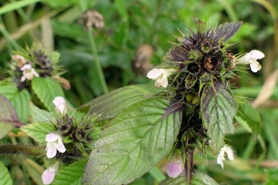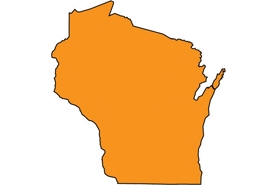Hemp nettle
(Galeopsis tetrahit)
Herbaceous annual that grows to be 1-3’ tall. Stems are square, swollen at leaf nodes, and covered with coarse, downward-pointing hairs intermixed with shorter glandular hairs.
Other names for this plant include:
- Common names: brittlestem hempnettle, common hemp nettle, hemp-nettle
- Scientific names: G. tetrahit var arvensis; G. tetrahit var bifida; G. tetrahit var tetrahit
Classification in Wisconsin: Restricted
- Ecological Threat
-
- It Invades roadsides, open woods, pastures and fields. In general, hemp nettle prefers disturbed sites creating monospecific stands.
- Hemp nettle is also considered an agricultural weed and is avoided by most grazers and also is the host for potato fungus and several nematodes.
- Identification
-
CAUTION: Wear long sleeves and gloves when handling. Hemp nettle exposure can irritate the skin in some people.
Leaves: Opposite, coarsely toothed and hairy on both sides. The actual shape can be variable.
Flowers: Purple to pink to white flowers in dense axillary clusters. It has five sharp points that protrude from the flowers—Bloom from June-September.
Fruits & seeds: Each flower produces four nutlets each containing one seed.
Roots: Taproot with lateral roots.
- Control
-
Mechanical: Dig up or hand-pull when in the flower bud stage. Dispose of in landfill since seeds can still mature after removed.
Chemical: Use Dicamba (230 mL/ha) mixed with MCPA (1.1 L/ha) [restricted use].
- Resources
- Sources for content:
- Galeopsis tetrahit [exit DNR]. In Klinkenberg, Brian. (Editor) 2012. E-Flora BC: Electronic Atlas of the Plants of British Columbia [eflora.bc.ca]. Lab for Advanced Spatial Analysis, Department of Geography, University of British Columbia, Vancouver.


